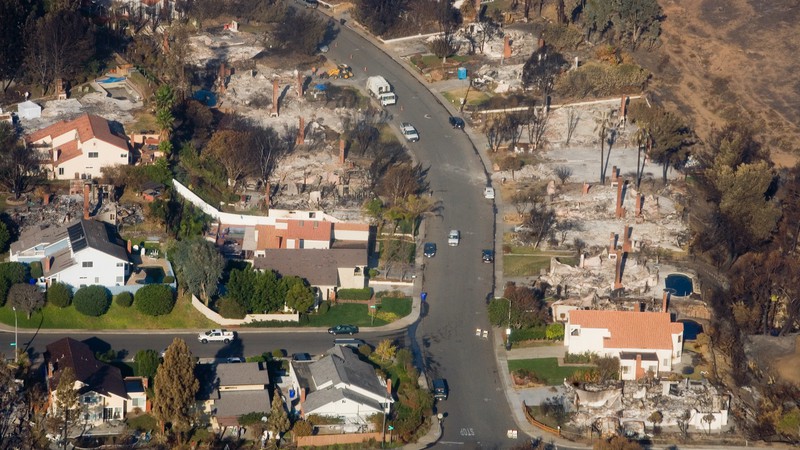The state tries persuading insurance companies to cover homes in fire zones.

Thousands of homeowners have been kicked off their fire insurance policies. Andrea Booher / WIkimedia Commons Public Domain
More than 2.5 million acres burned in in 2021 ccording to CalFire, including the 103-day, five-county Dixie Fire which alone burned 963,309 acres. More than 3,600 structures also burned in 2021—a staggering number but at the same time, a relatively modest number compared to the 11,116 structures burned in the calamity of 2020.
All of that destruction costs money. According to the Bay Area Council Economic Institute, 2020 fires caused between $5 billion and $9 billion worth of damage, while wildfires in 2017 and 2018 wreaked $10 billion worth of destruction. Much of that damage was done to homes and businesses where people live, and make their living. Someone has to pay for all of that fire damage, and that someone is the insurance industry.
But in California, insurance companies have been increasingly unwilling to provide coverage to homeowners whose properties sit in areas prone to fire, or have dramatically jacked up rates in those areas, making fire insurance largely unaffordable for many homeowners. Especially when they see the values of their homes plummet. A study published by the U.S Forest Service found that home values dropped by 10 percent after a wildfire in the area of the property, and by 23 percent after a second fire.
In 2019 alone, California insurance companies dumped about 230,000 homeowners due to fire risks. What is the state doing to protect homeowners whose homes lie directly in the path of a wildfire? The answer is—probably not enough.
“Safer From Fire” Program Gets Underway
In February 2022, under the heading “Safer From Fire,” Insurance Commissioner Ricardo Lara laid out a set of rules under which insurance companies would look at how well homeowners have protected their homes when they make their decision whether to provide coverage or not, as well their decisions on rates.
Insurers make those decisions based, at least in part, on a somewhat mysterious score that purports to evaluate a particular homeowner’s risk. Under the new rules, insurance companies must explain the factors that went into a homeowner’s score, giving them the chance to make improvements and fix problems.
Which leads to the heart of Lara’s “Safer From Fire” program—encouraging homeowners to “harden” their structures against fire. The idea is to entice the companies to grant coverage to homeowners based on how well they reduce their own fire risk—by taking such measures as fireproofing their roofs, installing double-pane windows to resist flames, clearing their yards of flammable dry vegetation, and other improvements.
If homeowners make the investment in such “hardening” measures, insurers must offer discounted premium rates. Which is great for customers who actually have policies. But nothing in the state’s new rules requires that insurance companies reinstate dropped policies, or offer coverage to anyone who doesn’t already have it.
So far, according to information from the California Department of Insurance, 17 insurance companies whose customers represent about 40 percent of the state’s fire insurance market, have started to offer the new, lower rates since the new guidelines went into effect.
FAIR Plan For Homeowners Who Lose Coverage
Lara has also placed a series of moratoriums on insurance companies dropping coverage for homeowners. But those bans on dropped coverage last only one year, and take effect only in specific areas. (The Department of Insurance website offers a Zip Code Lookup page to determine if a specific area is covered by a moratorium.)
For those who have lost coverage, or who could never get it in the first place, the state has had a plan in effect since 1968, called FAIR, to provide insurance for homes in high risk areas. The program, however, is not public insurance. Instead, it is established by insurance companies who pool their resources to distribute their risk.
To qualify for FAIR insurance, a hme must be a single-family dwelling, and must be occupied, and must not qualify for conventional marketplace insurance coverage. Rates under the plan tend to be higher than normal. But with the increasing number of fires, and the decreasing availability of insurance this “insurer of last resort,” as FAIR is often called, has grown in market share over the past five years.
In 2020, FAIR covered less than three percent of the state’s homeowners—but that was still 241,466 policies, an increase of more than 49,000 from the previous year, according to data from Lara’s office.
At the same time, the number of homeowners whose policies were dumped by their insurers dropped by 10 percent over the same time period, thanks largely to the cancellation moratoriums.
Long form articles which explain how something works, or provide context or background information about a current issue or topic.